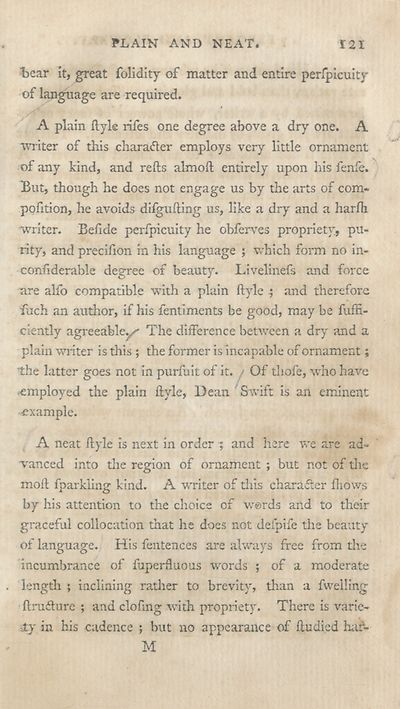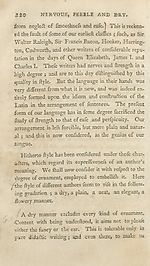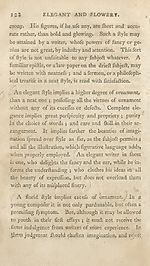Download files
Complete book:
Individual page:
Thumbnail gallery: Grid view | List view

PLAIN AND NEAT.
121
tear it, great folidity of matter and entire perfpicuity
of language are required.
A plain ftyle rifes one degree above a dry one. A
writer of this charaifter employs very little ornament
of any kind, and refts almoft entirely upon his fenfe.
But, though he does not engage us by the arts of com-
pofition, he avoids dilgulting us, like a dry and a harlh
writer. Befidc perfpicuity he obferves propriety, pu¬
rity, and precifion in his language ; which form no in-
confiderable degree of beauty. Livelinefs and force
-are alfo compatible with a plain ftyle $ and therefore
fuch an author, if his fentiments be good, may be fuffi-
ciently agreeable./' The difference between a dry and a
plain writer is this ; the former is incapable of ornament;
the latter goes not in purfuit of it. / Of thofe, who have
^employed the plain ftyle, Dean'Swift is an eminent
-example.
A neat ftyle is next in order ; and here we are ad¬
vanced into the region of ornament ; but not of the
moft fparkling kind. A writer of this character fliows
by his attention to the choice of words and to their
graceful collocation that he does not defpife the beauty
of language. His fentences are always free from the
incumbrance of fuperftuous words ; of a moderate
length ; inclining rather to brevity, than a fwelling
ftnidture ; and clofmg with propriety. There is varie-
Ly in his cadence ; but no appearance of ftudied haf*-
M
121
tear it, great folidity of matter and entire perfpicuity
of language are required.
A plain ftyle rifes one degree above a dry one. A
writer of this charaifter employs very little ornament
of any kind, and refts almoft entirely upon his fenfe.
But, though he does not engage us by the arts of com-
pofition, he avoids dilgulting us, like a dry and a harlh
writer. Befidc perfpicuity he obferves propriety, pu¬
rity, and precifion in his language ; which form no in-
confiderable degree of beauty. Livelinefs and force
-are alfo compatible with a plain ftyle $ and therefore
fuch an author, if his fentiments be good, may be fuffi-
ciently agreeable./' The difference between a dry and a
plain writer is this ; the former is incapable of ornament;
the latter goes not in purfuit of it. / Of thofe, who have
^employed the plain ftyle, Dean'Swift is an eminent
-example.
A neat ftyle is next in order ; and here we are ad¬
vanced into the region of ornament ; but not of the
moft fparkling kind. A writer of this character fliows
by his attention to the choice of words and to their
graceful collocation that he does not defpife the beauty
of language. His fentences are always free from the
incumbrance of fuperftuous words ; of a moderate
length ; inclining rather to brevity, than a fwelling
ftnidture ; and clofmg with propriety. There is varie-
Ly in his cadence ; but no appearance of ftudied haf*-
M
Set display mode to:
![]() Universal Viewer |
Universal Viewer | ![]() Mirador |
Large image | Transcription
Mirador |
Large image | Transcription
| Antiquarian books of Scotland > Languages & literature > Abridgement of lectures on rhetoric > (137) |
|---|
| Permanent URL | https://digital.nls.uk/135468098 |
|---|
| Description | Thousands of printed books from the Antiquarian Books of Scotland collection which dates from 1641 to the 1980s. The collection consists of 14,800 books which were published in Scotland or have a Scottish connection, e.g. through the author, printer or owner. Subjects covered include sport, education, diseases, adventure, occupations, Jacobites, politics and religion. Among the 29 languages represented are English, Gaelic, Italian, French, Russian and Swedish. |
|---|

